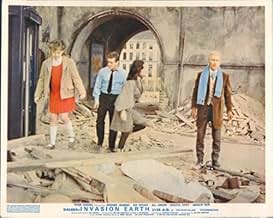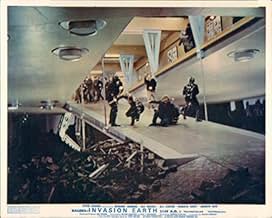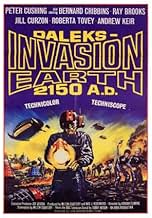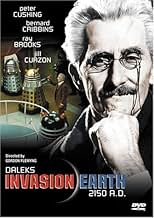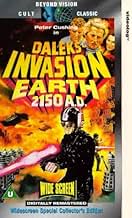Les Daleks envahissent la Terre
Original title: Daleks' Invasion Earth 2150 A.D.
- 1966
- Tous publics
- 1h 24m
IMDb RATING
5.9/10
4.8K
YOUR RATING
Dr. Who and his companions arrive on Earth in the year 2150 AD, only to discover that the planet has been invaded and its population enslaved by the dreaded Daleks.Dr. Who and his companions arrive on Earth in the year 2150 AD, only to discover that the planet has been invaded and its population enslaved by the dreaded Daleks.Dr. Who and his companions arrive on Earth in the year 2150 AD, only to discover that the planet has been invaded and its population enslaved by the dreaded Daleks.
Featured reviews
Daleks-Invasion-Earth:2150 AD, is an enormous improval on the preceeding film. It is more exciting and enjoyable and there is an impending sense of fear throughout the movie wich was evident in the Television series around this time. Peter Cushing gets to grips with his role as The Doctor in this movie. Bernard Cribbins comes on board and is fantastic. Ray Brooks and Jill Curzon enhance the swinging sixties fell apparent in the previous film, and the action never gives up. The multi coloured Daleks are a more frightening sight in a future decaying London thatn on there own planet, and the set designs and designs of the vicious Robomen are again superb. This is a juvenile movie, but enjoyable at that. For a new Doctor Who movie, someone like Tim Burton or Steven Spielberg should remake this, and they would have an absolute goldmine on their hands.
I sat through, and was utterly bored by, the first of the Peter Cushing/Dr Who movies, DR WHO AND THE DALEKS. It was a chore to sit through in places, a resolutely twee attempt to transfer the TV series to the big screen for children to enjoy. The good news is that this sequel is a different beast entirely, even though it brings back much of the same cast and crew (including the director).
Put simply, DALEKS INVASION EARTH: 2150 AD is an action-packed romp. If you think that scenes of Dalek war-bands patrolling the streets of a post-apocalyptic London sounds like a good time, then you'd be right. This is a film that sacrifices character set-up in favour of all out action, and it works a treat.
Cushing plays the crusty old buffoon once more, and the only reason he's not as irritating is because he's given far less screen time here. For most of the time his character is a mere observer, watching a guerrilla war between Ray Brooks (THE FLESH AND BLOOD SHOW) and his rebels and the Daleks and their goons. Bernard Cribbins contributes some comedy schtick, but he's nowhere near as irritating as Roy Castle was in the last one.
The technical effects are surprisingly decent, from the Dalek spaceships to the explosions, firefights, and large-scale destruction. Scenes of buildings collapsing are vivid and exciting and the Daleks are more of a menace here (and thankfully their voices aren't irritating anymore). There are lots of great visual moments, like the solitary Dalek rising out of the Thames or the humans vs. Dalek fight scenes. A rousing score and decent supporting cast serve as the icing on the cake here.
Put simply, DALEKS INVASION EARTH: 2150 AD is an action-packed romp. If you think that scenes of Dalek war-bands patrolling the streets of a post-apocalyptic London sounds like a good time, then you'd be right. This is a film that sacrifices character set-up in favour of all out action, and it works a treat.
Cushing plays the crusty old buffoon once more, and the only reason he's not as irritating is because he's given far less screen time here. For most of the time his character is a mere observer, watching a guerrilla war between Ray Brooks (THE FLESH AND BLOOD SHOW) and his rebels and the Daleks and their goons. Bernard Cribbins contributes some comedy schtick, but he's nowhere near as irritating as Roy Castle was in the last one.
The technical effects are surprisingly decent, from the Dalek spaceships to the explosions, firefights, and large-scale destruction. Scenes of buildings collapsing are vivid and exciting and the Daleks are more of a menace here (and thankfully their voices aren't irritating anymore). There are lots of great visual moments, like the solitary Dalek rising out of the Thames or the humans vs. Dalek fight scenes. A rousing score and decent supporting cast serve as the icing on the cake here.
Daleks-Invasion Earth: 2150 A.D. is directed by Gordon Flemyng and Milton Subotsky co-adapts the screenplay with Terry Nation and David Whitaker. It stars Peter Cushing, Bernard Cribbins, Ray Brooks, Andrew Keir, Jill Curzon and Roberta Tovey. A Technicolor/Techniscope production, with music by Barry Gray and Bill McGuffie and cinematography by John Wilcox.
A sequel to Dr. Who and the Daleks (1965), plot finds Cushing once again playing the Doctor, who after getting transported to 2150 A.D. finds London ravaged by the Daleks. The Daleks are turning humans into slave Robomen, but an underground human resistance offers hope. Can the Doctor and his companions aid the resistance and save Earth from Dalek damnation? Even though Dr. Who and the Daleks irked the Dr. Who fan base, understandably so since Amicus' version of the good Doctor is some way from the TV series version, it was enough of a success to warrant this sequel. You pretty much get a retread of the first film with the characterisations, Cushing's Doctor is a lovable old eccentric prof, two of his lady female relations are along for the ride (Tovey returning as the same character) and Cribbins has replaced Roy Castle as the light relief companion accidentally thrust into a chaotic world. The Daleks remain a unique and devilish foe, their voices unnerving and their colours vibrant in Technicolor.
Plot follows a familiar trajectory, much running, puffing, capture and escape histrionics, the good versus evil core booming throughout. The sets remain cheap, the effects basic but quaint, and the acting just about passes the test because everyone seems to be enjoying themselves and therefore performing it to the required standard. The music score is truly out of sync with the picture, at times it sounds like it belongs in a Carry On movie, at others an episode of The Avengers; in fact John Steed would have been a good addition to the plotting! But there is some darkness in the story, making it more potent than its prequel.
This wasn't as successful as the studio hoped, so a third film was shelved. If you aren't a hardcore Dr. Who fan and you can accept it on its own daft and fun terms? Then Daleks-Invasion Earth: 2150 A.D. is an enjoyable enough time filler. 6/10
A sequel to Dr. Who and the Daleks (1965), plot finds Cushing once again playing the Doctor, who after getting transported to 2150 A.D. finds London ravaged by the Daleks. The Daleks are turning humans into slave Robomen, but an underground human resistance offers hope. Can the Doctor and his companions aid the resistance and save Earth from Dalek damnation? Even though Dr. Who and the Daleks irked the Dr. Who fan base, understandably so since Amicus' version of the good Doctor is some way from the TV series version, it was enough of a success to warrant this sequel. You pretty much get a retread of the first film with the characterisations, Cushing's Doctor is a lovable old eccentric prof, two of his lady female relations are along for the ride (Tovey returning as the same character) and Cribbins has replaced Roy Castle as the light relief companion accidentally thrust into a chaotic world. The Daleks remain a unique and devilish foe, their voices unnerving and their colours vibrant in Technicolor.
Plot follows a familiar trajectory, much running, puffing, capture and escape histrionics, the good versus evil core booming throughout. The sets remain cheap, the effects basic but quaint, and the acting just about passes the test because everyone seems to be enjoying themselves and therefore performing it to the required standard. The music score is truly out of sync with the picture, at times it sounds like it belongs in a Carry On movie, at others an episode of The Avengers; in fact John Steed would have been a good addition to the plotting! But there is some darkness in the story, making it more potent than its prequel.
This wasn't as successful as the studio hoped, so a third film was shelved. If you aren't a hardcore Dr. Who fan and you can accept it on its own daft and fun terms? Then Daleks-Invasion Earth: 2150 A.D. is an enjoyable enough time filler. 6/10
The On Her Majesty's Secret Service of the Doctor Who world, the two Peter Cushing-Dalek films have seen occasional reappraisal that labels them as "coolly kitsch" or "lovably camp". In reality, of course, they're complete pants.
The Doctor Who TV series actually had a considerable integrity, despite being made on a budget of 50p and never managing to shake off the "Kid's Telly" tag. Here Cushing plays the Doctor of the title, his surname actually becoming "Who". The Tardis, his sophisticated space-time machine, is now "Tardis", a naff-looking thing with a Yale lock on the door. Around the time this was made a "Carry On" actor would do his only television work in the Doctor Who series Peter Butterworth as the Meddling Monk. For the film we got Bernard Cribbins as P.C. Tom Campbell, a similar character to the one that married the Doctor's granddaughter on TV. Though as the film Susan is only ten that would be inappropriate here.
Both films (the other Doctor Who and the Daleks, Cushing joined by Roy Castle) were based directly on actual TV stories, the novelty being they were in colour. By the time the second came around the novelty was over and it didn't do the business of the first, despite being someway the better film. Perhaps this is because the original serial The Dalek Invasion of Earth was an attempt to mount a film's epic scale on a TV budget. To this end it transfers better to the medium, and its setting (future Earth as opposed to the first film's alien planet Skaro) is more accessible to audiences.
The big failure is, of course, send-up. Some of the series' b-movie concepts (mutated nuclear war victims get robot-armoured shells and invade Earth to steal its core) are ludicrous, but played straight can be rewarding. The films make a mockery of the whole concept, showing a total lack of respect for their source material. My advice is: if you don't like 'em, don't make 'em. Bearing in mind the Daleks were hot merchandise properties at the time, this is a cynical cash-in on the nation's youth. There's even a shameless product placement for Sugar Puff Cereals.
All involved are capable of better. Peter Cushing, respected in adult horror films, here opts for a no-effort parody of TV Doctor William Hartnell's performance. There is no trace of depth or consideration for the part he has chosen. Full credit does go to Ray Brooks, Andrew Keir and Philip Madoc for at least trying to take it seriously. Madoc was rewarded with four seperate roles in the television series, most notably as mad scientist Solon (1976) and The War Lord (1969). On the plus side, direction in terms of camera angles is actually very, very good, but is offset by incidental music so loud and outdated that it works against the mood entirely. Think SF drama with Carry On music and you're almost there.
Bright and colourful, (including a funky red Dalek) the film certainly has visual appeal. But the Daleks' voices, their volume increased considerably, are extremely grating. They also lack their trademark warmth and charm, being little more than robots. Their weaponry was scheduled to be flame-throwers, but was disallowed due to the young audience. This is perhaps fortunate as their gas sprays aid the Nazi allegory. Best bit? The exploding shed.
Trite jazz, lame comic setpieces and binliner outfits, the film is on TV virtually every Bank Holiday in England. And you know the strangest part? As bad as it is, come next Bank Holiday I'll probably be tempted to see it again.
The Doctor Who TV series actually had a considerable integrity, despite being made on a budget of 50p and never managing to shake off the "Kid's Telly" tag. Here Cushing plays the Doctor of the title, his surname actually becoming "Who". The Tardis, his sophisticated space-time machine, is now "Tardis", a naff-looking thing with a Yale lock on the door. Around the time this was made a "Carry On" actor would do his only television work in the Doctor Who series Peter Butterworth as the Meddling Monk. For the film we got Bernard Cribbins as P.C. Tom Campbell, a similar character to the one that married the Doctor's granddaughter on TV. Though as the film Susan is only ten that would be inappropriate here.
Both films (the other Doctor Who and the Daleks, Cushing joined by Roy Castle) were based directly on actual TV stories, the novelty being they were in colour. By the time the second came around the novelty was over and it didn't do the business of the first, despite being someway the better film. Perhaps this is because the original serial The Dalek Invasion of Earth was an attempt to mount a film's epic scale on a TV budget. To this end it transfers better to the medium, and its setting (future Earth as opposed to the first film's alien planet Skaro) is more accessible to audiences.
The big failure is, of course, send-up. Some of the series' b-movie concepts (mutated nuclear war victims get robot-armoured shells and invade Earth to steal its core) are ludicrous, but played straight can be rewarding. The films make a mockery of the whole concept, showing a total lack of respect for their source material. My advice is: if you don't like 'em, don't make 'em. Bearing in mind the Daleks were hot merchandise properties at the time, this is a cynical cash-in on the nation's youth. There's even a shameless product placement for Sugar Puff Cereals.
All involved are capable of better. Peter Cushing, respected in adult horror films, here opts for a no-effort parody of TV Doctor William Hartnell's performance. There is no trace of depth or consideration for the part he has chosen. Full credit does go to Ray Brooks, Andrew Keir and Philip Madoc for at least trying to take it seriously. Madoc was rewarded with four seperate roles in the television series, most notably as mad scientist Solon (1976) and The War Lord (1969). On the plus side, direction in terms of camera angles is actually very, very good, but is offset by incidental music so loud and outdated that it works against the mood entirely. Think SF drama with Carry On music and you're almost there.
Bright and colourful, (including a funky red Dalek) the film certainly has visual appeal. But the Daleks' voices, their volume increased considerably, are extremely grating. They also lack their trademark warmth and charm, being little more than robots. Their weaponry was scheduled to be flame-throwers, but was disallowed due to the young audience. This is perhaps fortunate as their gas sprays aid the Nazi allegory. Best bit? The exploding shed.
Trite jazz, lame comic setpieces and binliner outfits, the film is on TV virtually every Bank Holiday in England. And you know the strangest part? As bad as it is, come next Bank Holiday I'll probably be tempted to see it again.
When I first saw this on TV as a kid, I was really taken with the fanciful far-out concepts of a conquered Earth. For a 12 year-old boy into sci-fi, this was and is the ultimate escapist fare. I had no knowledge of the British TV series at the time so my intro to Dr.Who was Peter Cushing (playing older than he is), the movie version of the old-time traditional Doctor. I probably saw this film before the previous one "Dr. Who and the Daleks" as I was puzzled by the Doctor's recognition of his old foes, the unforgettable Daleks. Yes, who can forget those frog-like voices, warped by metallics, usually screaming for the death of humans. The British cast is really keen, especially Cribbins as an out-of-place copper and Andrew Keir as a hobbled resistance fighter. They bring a curious reality to the fantastic setting.
The picture has a decidedly British flavor and, of course, is filmed in the British countryside. Though I didn't reason this out at the time when I was a kid, it had an obviously different taste to it; I was mostly familiar with U.S. low budget sci-fi pics of the '50s and '60s at the time. The scope of the picture seemed really huge back then: London in a destroyed state, humanity decimated. There was that really cool flying saucer, looking fully functional and detailed. And there were the creepy Robo-men, in their slick black bodysuits and far-out helmets, like some futuristic Nazis or space zombies. All of this stuff really just took me over and I couldn't wait for the next time the local TV channels would run it again (not very often, as it happened). Some years later, I realized the title, 2150 AD, sounded cool, but the invasion by the Daleks must have occurred only a few years before the events of this movie, and the dilapidated buildings all looked like they'd been wrecked in the sixties. Ah, no matter. Many years later, I got the DVD and the thrill, tho muted by the long passage of experience and adulthood, is still there. They really knew how to make 'em back then.
The picture has a decidedly British flavor and, of course, is filmed in the British countryside. Though I didn't reason this out at the time when I was a kid, it had an obviously different taste to it; I was mostly familiar with U.S. low budget sci-fi pics of the '50s and '60s at the time. The scope of the picture seemed really huge back then: London in a destroyed state, humanity decimated. There was that really cool flying saucer, looking fully functional and detailed. And there were the creepy Robo-men, in their slick black bodysuits and far-out helmets, like some futuristic Nazis or space zombies. All of this stuff really just took me over and I couldn't wait for the next time the local TV channels would run it again (not very often, as it happened). Some years later, I realized the title, 2150 AD, sounded cool, but the invasion by the Daleks must have occurred only a few years before the events of this movie, and the dilapidated buildings all looked like they'd been wrecked in the sixties. Ah, no matter. Many years later, I got the DVD and the thrill, tho muted by the long passage of experience and adulthood, is still there. They really knew how to make 'em back then.
Did you know
- TriviaPeter Cushing supposedly only agreed to do this film if Roberta Tovey returned as his grand-daughter alongside him, having built up a rapport on the previous film.
- GoofsThe Dalek in the Thames does not flash its lights when addressing the Robomen, as the casing did not contain an operator.
- Alternate versionsSome versions of the film open with the credits sequence before switching to Tom's night-time street patrol. The original version opens with the raid, then the titles, then Tom's awakening in TARDIS.
- ConnectionsFeatured in Movie 4: Invasion Earth, 2150 A.D. (1972)
- How long is Daleks' Invasion Earth 2150 A.D.?Powered by Alexa
Details
- Release date
- Country of origin
- Language
- Also known as
- Dr. Who: Daleks Invasion Earth 2150 A.D.
- Filming locations
- Slipway, Battersea Church Road, Battersea, London, Greater London, England, UK(Dalek rising out of the river)
- Production companies
- See more company credits at IMDbPro
Box office
- Budget
- £286,000 (estimated)
- Gross worldwide
- $115
Contribute to this page
Suggest an edit or add missing content

Top Gap
By what name was Les Daleks envahissent la Terre (1966) officially released in India in English?
Answer


